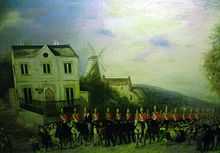Stamford Bull Run

The Stamford Bull Run was a bull-running and bull-baiting festival held on St Brice's Day (13 November) in the English town of Stamford, Lincolnshire for almost 700 years, until it was abandoned in 1837.[1] The custom dated from the time of King John.
Origins
According to local tradition, the origin of the custom dated from the time of King John (1199 - 1216) when William de Warenne, 5th Earl of Surrey, standing on the battlements of the castle, saw two bulls fighting in the meadow beneath. Some butchers came to part the combatants and one of the bulls ran into the town, causing a great uproar. The earl, mounting his horse, rode after the animal, and enjoyed the sport so much, that he gave the meadow in which the fight began to the butchers of Stamford on condition that they should provide a bull, to be run in the town every 13 November, for ever after.[2] The town of Stamford acquired common rights in the grassy flood plain next to the River Welland, which until the last century was known as Bull-meadow, and today just as The Meadows.
The Event
The event was officially opened by the ringing of St Mary’s Church bells at 10.45 am, announcing the closing and boarding of shops and the barricading of the street with carts and wagons. By 11 am crowds had gathered and the bull was released, baited by the cheering of the crowd, and (among other things) a man who would roll towards it in a barrel. It was then chased through the main street and down into the Welland River, where it was caught, killed and butchered. Its meat was often sold to the poor and as such the custom by the 1700s was supported as a charity by donations.
Seventeenth-century historians described how the bull was chased and tormented for the day before being driven to the Bull-meadow and slaughtered. "Its flesh [was] sold at a low rate to the people, who finished the day's amusement with a supper of bull-beef."[1]
Abandonment

The event was a time of drunken disorder. The custom was abandoned in the 19th century after a campaign by the Society for the Prevention of Cruelty to Animals and the intervention of special constables, the military and police brought in from outside.[1] Some Stamford residents defended their ancient custom as a "traditional, manly, English sport; inspiring courage, agility and presence of mind under danger." Its defenders argued that it was less cruel and dangerous than fox hunting, and one local newspaper asked "Who or what is this London Society that, usurping the place of constituted authorities, presumes to interfere with our ancient amusement?"[1]
The last bull run was in 1839. The last known witness of the bull running was James Fuller Scholes who spoke of it in a newspaper interview in 1928 before his 94th birthday; "I am the only Stamford man living who can remember the bull-running in the streets of the town. I can remember my mother showing me the bull and the horses and men and dogs that chased it. She kept the St Peter's Street - the building that was formerly the Chequers Inn at that time and she showed me the bull-running sport from a bedroom window. I was only four years old then, but I can clearly remember it all. The end of St Peter's Street (where it was joined by Rutland Terrace) was blocked by two farm wagons, and I saw the bull come to the end of the street and return again. My mother told me not to put my head out of the window - apparently because she was afraid I should drop into the street."[3]
References
- ↑ 1.0 1.1 1.2 1.3 Chambers Book of Days (1864),. W. & R. Chambers ltd. 1832. 13 November entry
- ↑ November Bull-Running in Stamford, Lincolnshire; Martin W. Walsh. Journal of Popular Culture
- ↑ "Stamford & District News (Closed 1942),". Interview, 20 August 1928.